Powering Technologies For Network Devices
An Examination of Use, Familiarity, and Interest

Looking at the challenges of a typical Internet of Things (IoT) rollout, the biggest hurdle usually isn’t how to connect IoT devices to the LAN. Instead getting power cheaply and reliably to the device is often a far more difficult problem. For example, installing AC power outlets next to every IoT device is laborious and cost prohibitive. It’s also overkill considering the relatively low amount of voltage required by most IoT endpoints. Therefore, power over Ethernet (PoE) has become a must-have technology for virtually every enterprise and industrial IoT rollout. That said, PoE installations come with their own set of unique challenges.
Cable professionals, integrators and administrators must possess a certain level of knowledge when it comes to understanding what is needed from a power delivery perspective. Additionally, because PoE standards and use-cases are constantly expanding, deploying and managing PoE endpoints and IoT devices requires a tool that provides granular visibility into whether a PoE device will be able to draw sufficient power across copper cabling for extended periods of time.
When an IoT rollout requires the assurance that PoE across twisted pair cabling will operate in production as expected, three unique testing phases emerge throughout the lifecycle of the deployment:
Let’s drill down a bit further to understand the types of PoE tests that should be run, the different types of cabling to choose from based on PoE needs, the importance of cable certification for new installs and how to choose an AEM test tool based on job role.
According to the IEEE, power over Ethernet is comprised of three components: power sourcing equipment (PSE), the powered device (PD) and the cabling used to deliver power to the device. Examples of power sourcing equipment is the switch or midspan power injector and an example of a PD is a security camera.
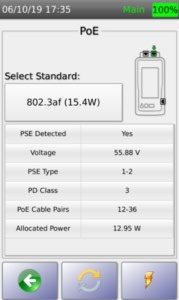
Understand that twisted-pair copper cabling is dual purpose in the fact that it not only carries electricity to power the device – but is also used to also used for Ethernet data transport.
Understand that twisted-pair copper cabling is dual purpose in the fact that it not only carries electricity to power the device – but is also used to also used for Ethernet data transport.
There are several IEEE twisted pair PoE standards that exist today. Each one delivers varying power levels from the PSE to the PD. These standards also provide the necessary signaling that both the PSE and PD will understand. The signaling is used to detect whether the PD indeed needs power as well as a negotiation process to determine the amount of power the PD requires for operation. Currently, there are eight different power classes available as defined by the IEEE. The power delivered by the PSE ranges from 4 Watts in a class 1 device to 90 Watts in a class 8 device. To learn more about the most popular IEEE PoE and PoDL standards, check out our detailed blog here.
When planning for PoE rollouts, it’s important that both the PSE and cabling be thoroughly tested to verify proper operation within the various PoE classes. This includes not only peak Wattage capacity – but also sustained power delivery over time and whether the cabling can succumb to DC resistance unbalance issues. Extended testing for DC resistance unbalance has become an essential step within the IoT deployment process as devices that require PoE++ levels of power at 60W or higher are more prone to causing significant interference problems with data delivery. Thus, for IoT implementations that require higher power delivery levels such as modern wireless access points (WAPs) and panto-tilt (PTZ) cameras, thorough testing of DC resistance unbalance is highly recommended.


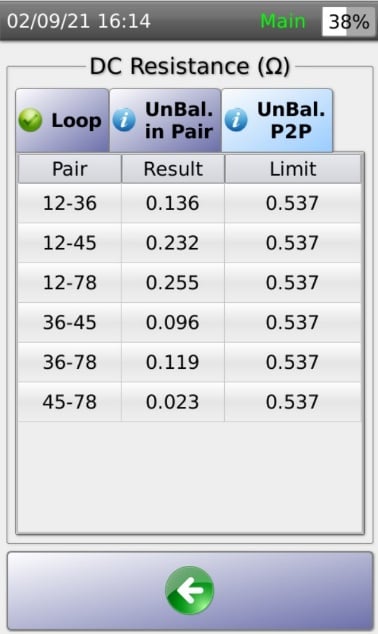
Finally, both PoE load and negotiation testing will ensure a smooth PoE endpoint rollout with far fewer issues related to long-term power delivery use and Wattage mismatches.
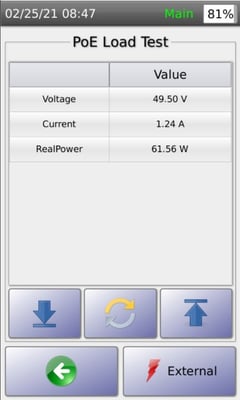
IEEE standards define different levels of powering. PoE also follows the same distance limitation of 100meter that twisted pair cabling runs follow, as power level will decrease as it traverses the wire. This is why the standards defines power levels at both the PSE and PD.
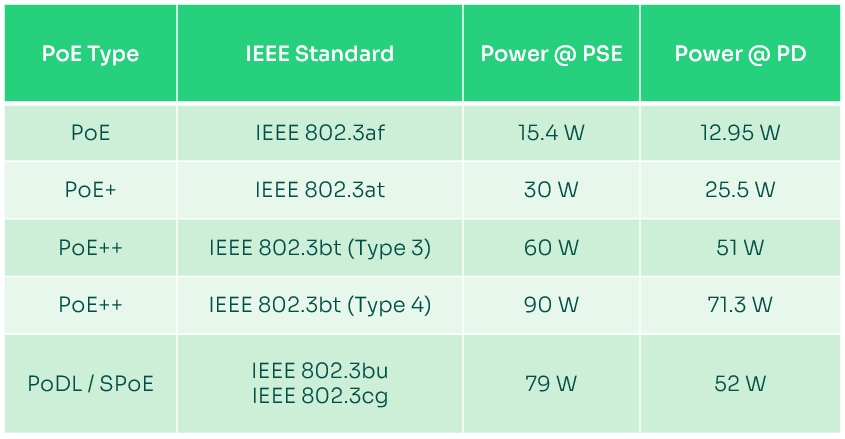
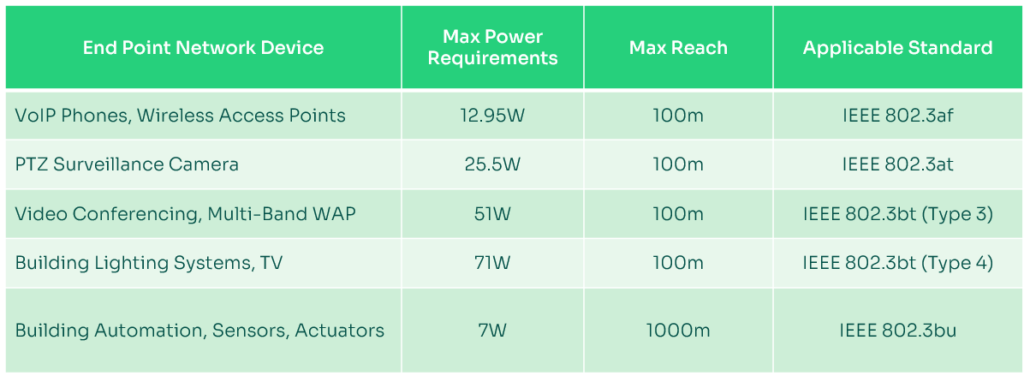
There are several Ethernet cable standards that PoE can operate across. Some cable types are better than others depending on the wattage your PDs require. Within common office and manufacturing deployment environments, you’ll likely come across existing four-pair copper cabling using CAT5, CAT5e and CAT6 standards. PD’s requiring lower wattage can utilize this older cabling.
However, it’s highly recommended that when powering devices that require 60W or higher sent over the cabling, newer CAT6A and higher cabling should be run. These types of cables use thicker conductor diameters that helps reduce resistance. This is critical so that power is not lost due to compounding resistance over longer cable runs. CAT6A and higher cabling is also better insulated and can handle the added heat produced by the higher power loads being sent across the wires. This is especially important when running higherwattage PoE in large cabling bundles. Lastly, thicker cables are far more capable at delivering higher power and faster Ethernet transmission speeds for multi-gigabit connections over twisted pair copper. Thus, running newer cabling future-proofs your IoT investment.
To increase the likelihood that your cabling won’t be an issue when running PoE, it’s necessary for cabling contractors to certify cabling to meet the cable manufacturers strict standards. This is true not only in terms of ensuring that the cabling can operate at multi-gigabit speeds – but also to test and ensure proper power load capacity for IEEE 802.3af, 802.3at and 802.3bt standards.
Any successful IoT deployment requires that the proper tools be in place to get the job done right the first time. Within AEM’s product portfolio, there are two test tools that can assist with any PoE project for planning, testing and troubleshooting purposes
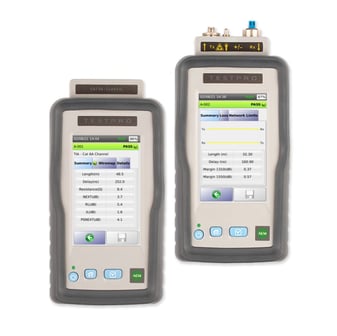
When looking at copper cabling for both Ethernet transport and PoE, placing an AEM TestPro CV100 in your cable contractor’s hand is the best way to your cable plant will work as intended. For one, the TestPro can fully certify new and existing cabling to meet the cable manufacturer’s warranty standards. Doing so ensures the cabling – and the install – were properly completed and is ready for production use. Tests not only verify that cabling can operate properly up to multi-gigabit speeds – but also that sustained PoE load validation tests have been performed up to 90 Watts per cable.
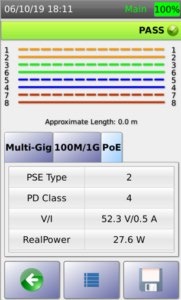
The TestPro will also be your best friend when it comes to troubleshooting cabling problems that will undoubtedly arise. Finding the root cause of a cable performance or PoE issue can be a real challenge without the proper test tool at the ready. With an industry best 6 second autotest, a TestPro can identify and locate common issues such as the locations of copper faults, propagation delay, and DC resistance unbalance. Thus, having a TestPro is both a certification and troubleshooting time and money saver in the long run.
For network administrators looking to test for PoE across existing cabling, the AEM Network Service Assistant (NSA) Qualification+ tool is a wonderful and lower-cost option as it allows for all the same PoE test features of the CV100 with the exception that it does not perform a full, double-ended certification tests.

If you plan to significantly expand your reliance on PoE, the first place to ensure success is to test your cabling. To be certain that both new and existing cable runs will meet your needs, thorough testing is an absolute must. The best way to be sure you won’t run into problems down the road is to use a copper certification test tool like the TestPro or a Qualification+ tool like the Network Service Assistant that can verify both data transport performance as well as power load testing. Only then can you be sure that your cabling is ready for a production environment.
Ready to learn more about how AEM's award-winning test solutions can help you achieve your cable testing needs? Request a demo with our team.
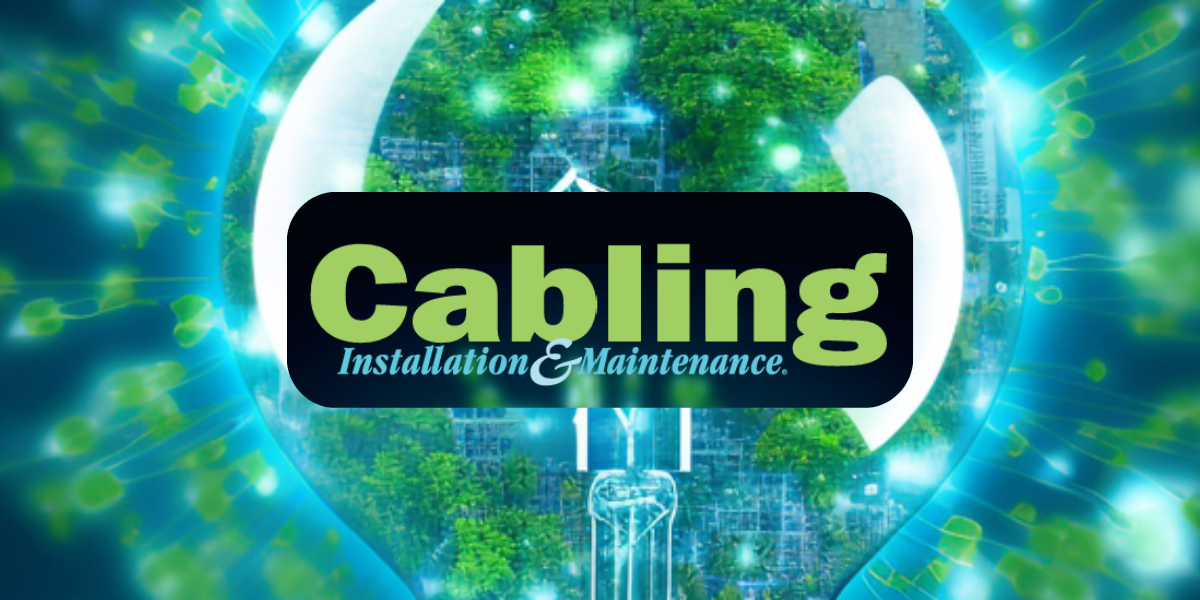
An Examination of Use, Familiarity, and Interest

Part 3 of a 3-part Series This is part 3 of a 3-part series. To view the previous 2 parts, click...
-1.png)
Part 2 of a 3-part Series This is part 2 of a 3-part series. To view Part 1, Common Data Center...
Leave a comment